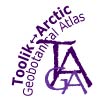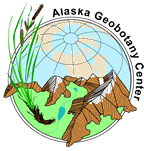Braun-Blanquet Names
Glossary - Braun-Blanquet Names - Plant Functional Types - Topographic Gradients
We include the Braun-Blanquet names for plant communities that fit into B-B units that have been described for Alaska. For example, the Dryas community Dryas integrifolia-Carex rupestris is referred to in the Braun-Blanquet approach by the name Association Carici-Dryadetum integrifoliae (Daniëls 1982) that has been described in Greenland and other parts of the Arctic.
The Braun-Blanquet (B-B) approach has a great many advantages for vegetation classification in the Arctic, where so many of the units have a circumpolar distribution and an international Arctic-wide classification seems achievable. The B-B approach has been used extensively to describe Arctic vegetation in much of northern Europe (Dierssen 1996), Arctic Russia (Matveyeva 2006), Svalbard (Elvebakk 1994), Greenland (Daniëls 1982, Daniëls 1994), parts of Canada (Lambert 1972, Thannheiser 1976, Thannheiser and Hellfritz 1989, Thannheiser and Geesink 1990, Vonlanthen et al. 2008), northern Alaska (Walker et al. 1994, Schickhoff et al. 2002, Kade et al. 2005), alpine areas of Arctic Greenland (Sieg and Drees 2007), the Brooks Range, Alaska (Cooper 1986), and subarctic Aleutian Islands (Talbot et al. 2005). The Braun-Blanquet approach includes standard international protocols for sampling, analyzing, and publishing the plant community names (Braun-Blanquet 1964, Westhoff and van der Maarel 1978, Weber et al. 2000). These recent studies could provide examples and a foundation for other arctic tundra classification studies using the Braun-Blanquet approach.
The approach has not been widely used in much of the rest of North America because of its foreign nomenclature system and the generally poor understanding that North Americans have of the method. (Braun-Blanquet Association names have an –etum suffix attached to the genus name of the dominant species and use various other protocols consistent with Latin naming conventions (e.g. Sphagno-Eriophoretum vaginati).) Much of the literature is in German and French and not generally accessible to English-speaking users. The recent development of a U.S. National Vegetation Classification (Jennings et al. 2009) will likely further reduce application of the method in North American. However, the sampling and analytical methods are similar in both approaches and lend themselves to units being described by both systems. We would strongly encourage this to promote international collaboration on the development of an Arctic-wide vegetation classification (Walker et al. 1994).
In this Atlas, all plant-community names used on the vegetation maps use a two-species form similar to that used in the U. S. National Vegetation Classification, but we also include Braun-Blanquet names where possible because we feel that these names are the gold standard that can be immediately identified and understood by vegetation scientists outside the U. S.



